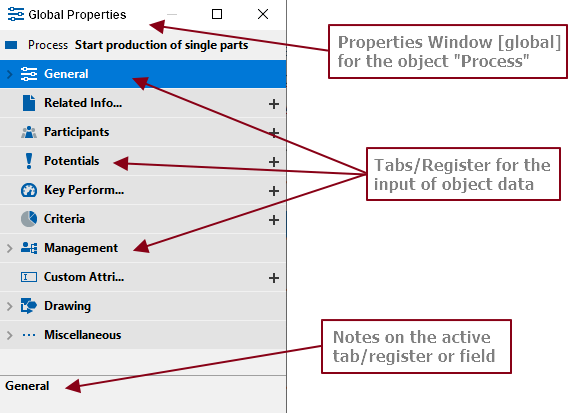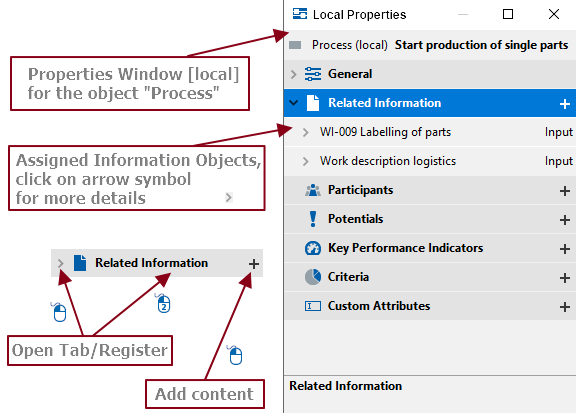The Properties Window
Applies to: viflow (subscription | 9 | 8) | Article: 1563822 | Updated on 30.04.2024
The properties window is the most important tool in modeling. All data relating to the respective object are entered here.
Contents of the Properties Window
The contents of the various properties windows can vary greatly, depending on the object type. In the properties windows for the main viflow objects – processes, information, areas – there are significantly more tabs for entering object data than, for example, in the property windows of key figures or measures. In addition to the global properties, the viflow main objects also have local properties that are displayed in the [global] and [local] property windows.


To open a tab and view the data assigned so far, click the arrow icon [  ] in front of the name of the tab or double on the title line.
] in front of the name of the tab or double on the title line.
With the plus button [  ] you can add object properties, such as information or participants.
] you can add object properties, such as information or participants.
Open the Properties Window
There are several methods for opening the properties of individual viflow objects. The table below summarizes the most important options:
viflow object |
action to open |
Properties [global] / [local] |
|
double click [ |
Properties window [global] + [local] are opened |
|
double click [
|
Properties window [global] opens |
|
|
double click [
|
Properties window [global] opens |
|
right click [ |
Properties windows [global] + [local] are opened |
|
|
To mark [
and click the Properties button on the Home or View tabs |
Properties window [global] opens |
|
|
right click [ |
Properties window [global] opens |
To mark [ |
Properties window [global] opens |
Global and local properties
All data of a process model is stored centrally in viflow. Changes to these global properties take effect wherever the object is used in the process model. Global properties are, for example, the name and shape text of processes. For example, if the Design a Product process is renamed to Design, this change applies wherever the process is used.
In contrast, there are the local properties. These can vary with the same viflow object and thus be different in each use of the object. Example: The order processing process is used in four places in the project for the processes in four different branches. The name, shape text and other data always remain the same, but the annotation texts and the participants vary in the four different uses (or branches).
Other local properties can be stored elsewhere for one and the same object. Wherever it is possible to differentiate between global and local properties, the [global] and [local] property windows can be called up.

So that global properties are not accidentally changed in all, possibly very frequent, uses, there is the option Display warning on multiple use, which can be deactivated under ››› Options – User Interface – Property Window.
Show and hide tabs
If not all the tabs used in the properties window are required, they can be hidden and displayed again under ››› Options – User Interface – Property Window.
 ] or double on the title line.
] or double on the title line..png) ] to [P/I/A] (without subprocesses/shading) in the graph
] to [P/I/A] (without subprocesses/shading) in the graph.png) ] to [P/I/A] (without subprocesses) in the windows
] to [P/I/A] (without subprocesses) in the windows.png) ] to [P/I/A] (without subprocesses) in the windows
] to [P/I/A] (without subprocesses) in the windows.png) ] on [P/I/A] in graphic and selection of properties in the context menu
] on [P/I/A] in graphic and selection of properties in the context menu.png)
.png) ] on an object in the respective Properties window in the context menu
] on an object in the respective Properties window in the context menu.png) ] of an object in the respective window and click on the Properties button in the Home or View tabs
] of an object in the respective window and click on the Properties button in the Home or View tabs
.png) ] of an object.
] of an object.